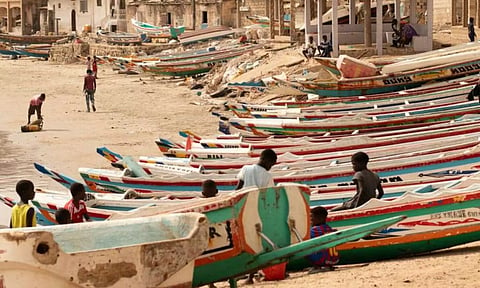

Robert Ade, Philipp Sandner
The departure of her 19-year-old son for Spain took Aminata Boye by surprise. “I was not informed when he left,” Boye told DW in Senegal’s coastal city of Mbour. “When I asked about him, they told me that he had taken to the sea.” For the last three months, Boye hasn’t heard one word from her son.
“His phone rang, but he didn’t answer,” she said. Now, the young man is among those who have been reported missing somewhere around the Canary Islands. “I lost my child at sea,” said Boye, desperate. She isn’t alone: many women in Mbour have a similar story to tell.
For Codou Boye, however, the situation is different, though no less difficult. Her husband is stuck in Spain, she told DW, waiting for paperwork to be settled. At least he regularly transfers some money back home.
“We struggle, sometimes we don’t manage to meet our children’s needs,” she said. “Life is difficult here, but there’s no point in going off to beg elsewhere. We don’t know what will happen to him or how long he will stay there.”
Many migrants have set off from Senegal in recent months, but specific figures are hard to come by. The country’s navy has stepped up its patrols along the coast and says it has intercepted several thousand illegal migrants since July.
Asked by DW for exact figures, government officials said they are known but “confidential.” However, those who survive the perilous journey in packed boats to the Canary Islands are once again counted. As of October 1, the UNHCR had registered about 15,406 arrivals in 2023 alone.
From Senegal, migrants travel between 1,500 and 2,100 kilometers (up to 1,300 miles) to the Canary Islands, which, as part of Spain, are the gateway to Europe.
For German anthropologist Markus Rudolf, the recent increase isn’t surprising. He said it can be attributed to a resurgence of migration after the COVID-19 pandemic. The systematic closing of other migratory routes has also added to the problem, said Rudolf, an affiliated senior researcher at Addis Ababa University.
Senegal’s internal political crisis has further exacerbated the situation. In recent months, court action against the popular jailed opposition figure Ousmane Sonko has repeatedly stirred protest, leaving at least 16 people dead. Before his imprisonment, Sonko was considered a promising candidate in next year’s presidential election.
“The domestic situation is hopeless,” said Rudolf. “The protests have led to even greater resignation.” This comes amid ongoing economic hardship, with many Senegalese struggling to make ends meet. That has made remittances from family members in Europe all the more important, said Rudolf.
Other destinations have also been spoken about on social media as being attractive for migrants, he added. Nicaragua, for example, is sometimes seen as an easy way to get to the United States, but in reality this has repeatedly turned out to be a misconception.
“Why people should first come to the Canary Islands and then — without valid papers — try to continue to America is beyond me,” said Rudolf.
Nevertheless, there are groups in Senegal that are trying to persuade people to stay. Among them is the National Association of Migrant Partners (ANPM), which is trying to raise awareness about the problems that those who leave will likely cause for those left behind.
In Mbour, the ANPM also tries to help the women who are mourning their loved ones and at the same time having to cope with a lack income previously provided by their departed family members.